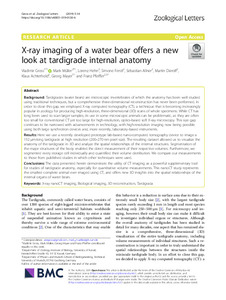| dc.date.accessioned | 2019-05-22T05:57:22Z | |
| dc.date.available | 2019-05-22T05:57:22Z | |
| dc.date.issued | 2019-05-11 | |
| dc.identifier | doi:10.17170/kobra-20190521508 | |
| dc.identifier.uri | http://hdl.handle.net/123456789/11246 | |
| dc.description.sponsorship | Gefördert durch den Publikationsfonds der Universität Kassel | |
| dc.language.iso | eng | |
| dc.rights | Urheberrechtlich geschützt | |
| dc.rights.uri | https://rightsstatements.org/page/InC/1.0/ | |
| dc.subject | X-ray nanoCT imaging | eng |
| dc.subject | Biological imaging | eng |
| dc.subject | 3D reconstruction | eng |
| dc.subject | Tardigrada | eng |
| dc.subject.ddc | 570 | |
| dc.title | X-ray imaging of a water bear offers a new look at tardigrade internal anatomy | eng |
| dc.type | Aufsatz | |
| dcterms.abstract | Background:
Tardigrades (water bears) are microscopic invertebrates of which the anatomy has been well studied using traditional techniques, but a comprehensive three-dimensional reconstruction has never been performed. In order to close this gap, we employed X-ray computed tomography (CT), a technique that is becoming increasingly popular in zoology for producing high-resolution, three-dimensional (3D) scans of whole specimens. While CT has long been used to scan larger samples, its use in some microscopic animals can be problematic, as they are often too small for conventional CT yet too large for high-resolution, optics-based soft X-ray microscopy. This size gap continues to be narrowed with advancements in technology, with high-resolution imaging now being possible using both large synchrotron devices and, more recently, laboratory-based instruments.
Results:
Here we use a recently developed prototype lab-based nano-computed tomography device to image a 152 μm-long tardigrade at high resolution (200–270 nm pixel size). The resulting dataset allowed us to visualize the anatomy of the tardigrade in 3D and analyze the spatial relationships of the internal structures. Segmentation of the major structures of the body enabled the direct measurement of their respective volumes. Furthermore, we segmented every storage cell individually and quantified their volume distribution. We compare our measurements to those from published studies in which other techniques were used.
Conclusions:
The data presented herein demonstrate the utility of CT imaging as a powerful supplementary tool for studies of tardigrade anatomy, especially for quantitative volume measurements. This nanoCT study represents the smallest complete animal ever imaged using CT, and offers new 3D insights into the spatial relationships of the internal organs of water bears. | eng |
| dcterms.accessRights | open access | |
| dcterms.creator | Gross, Vladimir | |
| dcterms.creator | Müller, Mark | |
| dcterms.creator | Hehn, Lorenz | |
| dcterms.creator | Ferstl, Simone | |
| dcterms.creator | Allner, Sebastian | |
| dcterms.creator | Dierolf, Martin | |
| dcterms.creator | Achterhold, Klaus | |
| dcterms.creator | Mayer, Georg | |
| dcterms.creator | Pfeiffer, Franz | |
| dc.relation.doi | doi:10.1186/s40851-019-0130-6 | |
| dc.type.version | publishedVersion | |
| dcterms.source.identifier | ISSN: 2056-306X | |
| dcterms.source.journal | Zoological Letters | |
| dcterms.source.pageinfo | 14 | |
| dcterms.source.volume | 5 | |

